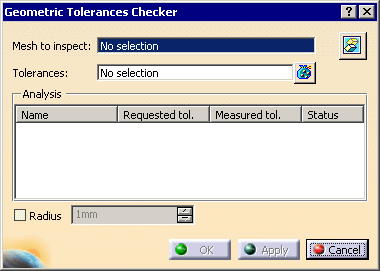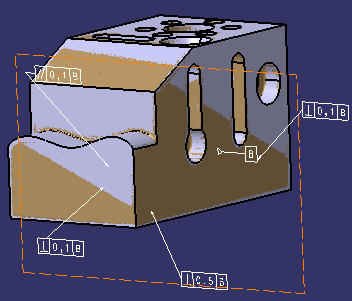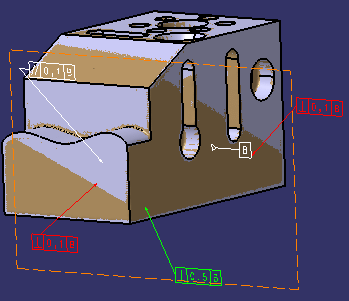
|
This task will show you how to check geometric tolerances
and include the result in a deviation report.
The Geometric Tolerances Checker:
- Reads and decodes geometric tolerances applied on CAD data,
- Accurately evaluates actual size, position and form of the mesh for
each selected tolerance,
- Provides you with an OK/KO status for each tolerance,
- Summarizes the results in a report.
|
 |
- Only the following tolerances are supported in this release:
| Tolerance Type |
Tolerance Name |
Applying to |
| form |
flatness |
so called planar surface |
| form |
cylindricity |
so called cylindrical surface |
| form |
circularity |
so called cylindrical or conical surface |
| form |
straightness |
cylinder axis |
| orientation |
parallelism |
surface/reference plane |
| orientation |
perpendicularity |
surface/reference plane |
| orientation |
angularity |
surface/reference plane |
- Reference planes are currently computed as mean planes. True
reference planes computation based on infinite norm are not yet
supported.
|
 |
The mesh must be properly aligned with the corresponding exact CAD data (by
best fit for example).
In order to be properly analyzed, the mesh must be segmented into different
areas. An automatic segmentation is provided inside the command, but you can use any other segmentation tool as well (before entering the
command):
- If the input is an already segmented mesh, the command takes this
segmentation into account. No automatic segmentation is
started. This way, you have full control over the segmentation used
within the command.
- If input is a non-segmented mesh (a mesh with just one internal cell),
the automatic segmentation is started (this segmentation is guided by the
aligned exact geometry, hence the requirement of a proper alignment).
Open the
GeometricTolerancesChecker01.CATPart from the samples directory. |
 |
-
Click Geometric Tolerances Checker
 in the Check Deviation toolbar.
in the Check Deviation toolbar.
The dialog box is displayed.

-
Select the
Mesh to inspect.

-
Select the geometric tolerances you want to check:
-
Either pick them directly,
-
or pick the CAD surfaces related to them in the
3D view (In this case, tolerances are deduced from the
surfaces.)
-
Multi-selection
 is available.
is available.
The supported tolerances are listed with their
requested tolerances:

Selecting one line in the dialog box highlights the mesh zone
computed to extract the primitive used to measure that FTA.
|
-
Optional: Select the
Radius check box: when the cloud of points is noisy, it is difficult to
have the boundaries of the CAD surface going through
all the points.
When you select this check box, the points inside a circular pipe centered on the
surface edge are not taken into account. You can set the value of this
radius.
This option being useless for already segmented input meshes, it is
available for non segmented meshes only (grayed otherwise). -
Click Apply to start the inspection.
-
Each tolerance is
evaluated and the measured value is displayed, with an OK/KO
status:

-
The tolerances in the 3D
view are painted in red or green accordingly.

|
-
Click
OK to validate and exit the command.
The inspection display is erased from the screen.
A feature GD&T Check.x is created in the specification tree
under the Deviation Check node.

-
Either add the GD&T Check.x feature as a
More Elements to Export in a Deviation Report:
- Click Deviation Report
 in the Check Deviation toolbar.
in the Check Deviation toolbar.
- Go to the Deviation tab and to More
Elements to Export.

- Click Add and select the GD&T Check.x
you have created (you can select several GD&T
Check.x features).
- The exported report looks like this:

Each GD&T Check.x feature has its own
section in the Deviation check results web page,
and can be accessed directly from the navigation panel.
|
-
Or capture the image of the GD&T Check.x
feature to insert it in the deviation report.
- Double-click the GD&T Check.x feature
to display it.
- Create the image with the Tools > Images > Capture
menu or by any other means.
- Click Deviation Report
 in the Check Deviation toolbar.
in the Check Deviation toolbar.
- Go to the Insert Images tab and click Add.
Select the image to insert.

- The exported report looks like this:

|
|
|

|